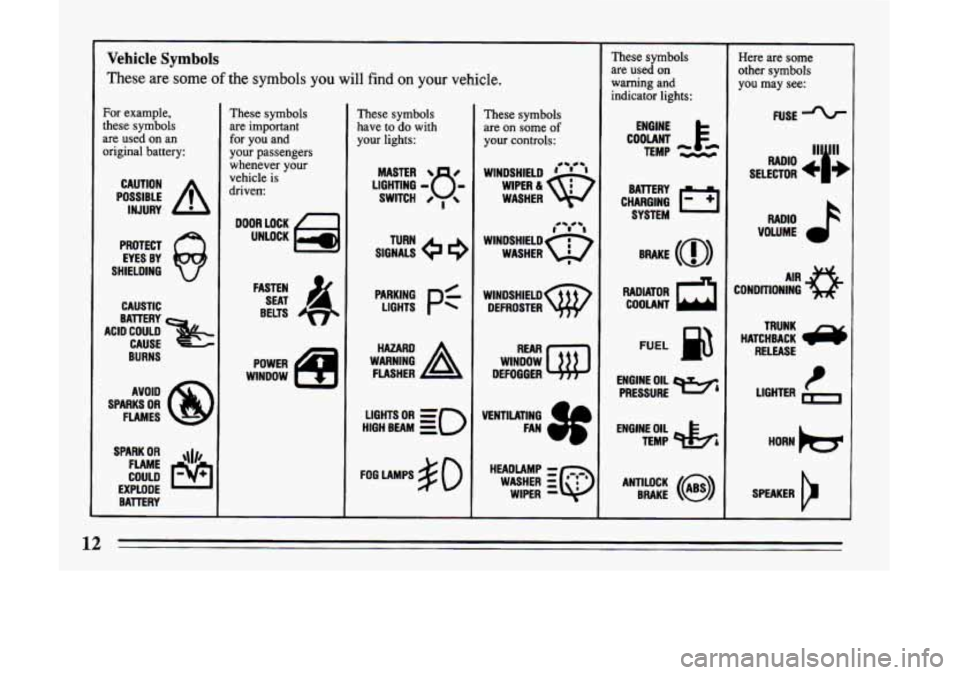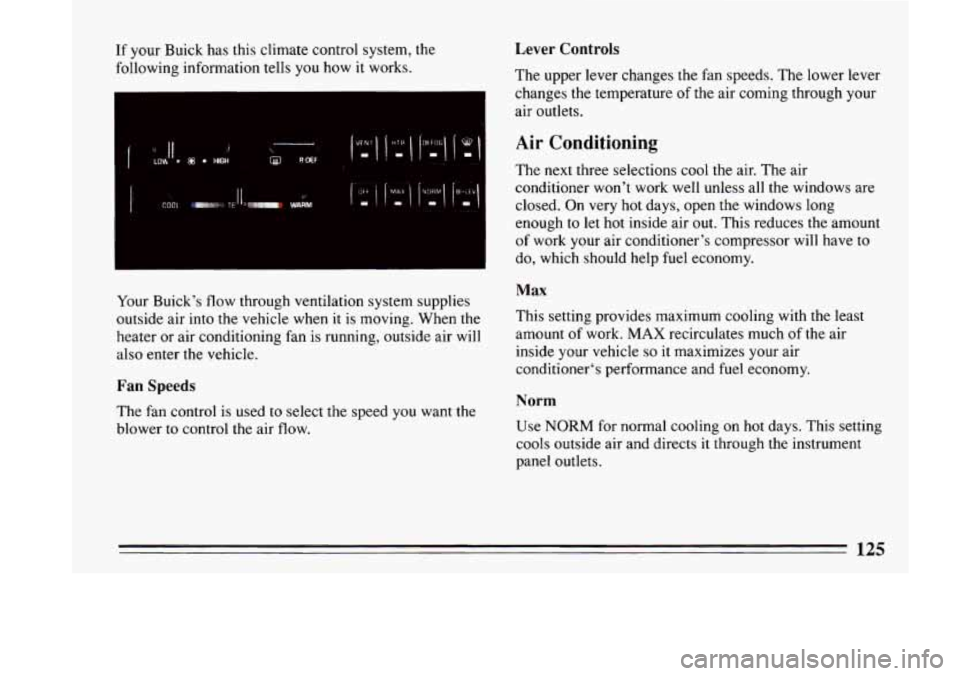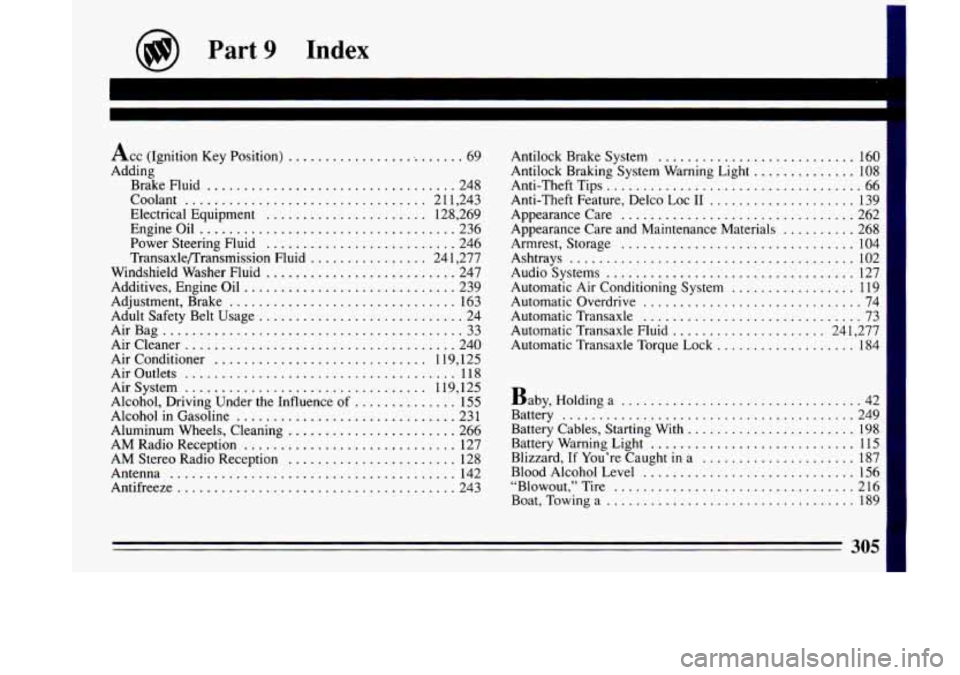1993 BUICK LESABRE air conditioning
[x] Cancel search: air conditioningPage 14 of 324

Vehicle Symbols
These
are some of the symbols you will find on your vehicle.
For example,
these symbols
are used on an
original battery:
POSSIBLE A
CAUTION
INJURY
PROTECT EYES BY
SHIELDING
Q
CAUSTIC
BURNS AVOID
SPARKS
OR
FLAMES
SPARK
OR ,\I/,
COULD FLAME
EXPLODE BATTERY
These symbols
are important
for you and
your passengers
whenever your
vehicle is
driven
DOOR LOCK
UNLOCK
FASTEN SEAT
4
BELTS
WINDOW POWER
These symbols
have
to do with
your lights:
LIGHTING - 8 -
MASTER 8
SWITCH 0 ,
SIGNALS e 9
TURN
LIGHTS
Pf
HIGH BEAM OR = =o
FOG LAMPS # 0
These symbols
are on some
of
your controls:
WINDSHIELD ' ' ' 4- e-
WASHER
wlNDsHIELDw DEFROSTER
WINDOW
DEFOGGER
HEADLAMP
- r~.c.r
WASHER :Q
WIPER -
These symbols
are used on
warning and
indicator lights:
COOLANT F*
TEMP -.--
ENGINE
CHARGING
I-1
BATTERY SYSTEM
RADIATOR
a
COOLANT
FUEL
ENGINE OIL
PRESSURE
TEMP OIL
&
ANTILOCK (@)
BRAKE
Here are some
other symbols
you
may see:
FUSE
RADIO >
VOLUME
CONDITIONING
AIR 33
HATCHBACK /y
TRUNK
RELEASE
t LIGHTER
Page 127 of 324

If your Buick has this climate control system, the
following information tells you how it works.
Your Buick's flow through ventilation system supplies
outside air into
the vehicle when it is moving. When the
heater or air conditioning fan is running, outside air
will
also enter the vehicle.
Fan Speeds
The fan control is used to select the speed you want the
blower to control the air flow.
Lever Controls
The upper lever changes the fan speeds. The lower lever
changes the temperature
of the air coming through your
air outlets.
Air Conditioning
The next three selections cool the air. The air
conditioner won't work well unless all the windows are
closed. On very hot days, open the windows long
enough
to let hot inside air out. This reduces the amount
of work your air conditioner's compressor will have to
do, which should help fuel economy.
Max
This setting provides maximum cooling with the least
amount of work.
MAX recirculates much of the air
inside your vehicle
so it maximizes your air
conditioner's performance and fuel economy.
Norm
Use NORM for normal cooling on hot days. This setting
cools outside air and directs it through the instrument
panel outlets.
125
Page 128 of 324

Bi-Level
This setting is designed for use on sunny days when the
air is only moderately warm or
cool. On days like these,
the sun may adequately warm your upper body, but your
lower body may
not be warm enough.
The Bi-level setting directs outside air into your vehicle
in two ways. Cool air is directed toward your upper
body through the instrument panel outlets, while slightly
warmed air is directed through the heater outlet at your
feet.
The air conditioner compressor operates in all Air
Conditioning positions and the Defrost position when
the outside temperature is above
48 OF (9OC).
When you don’t need to cool the outside air, use the
VENT, HEAT, or DEFROST settings. Adjust the
temperature control for comfort. You’ll get better fuel
economy (gas mileage) if you’re
not cooling the outside
air. When
you cool the air, your engine runs a
refrigeration compressor, and it has to work harder.
Vent
For mild outside temperature, when little heating or
cooling is needed, use the
VENT setting. Air will flow
through the instrument panel outlets. Use
the air outlets to
turn on, adjust and turn
off the air flow. Adjust the
temperature lever to the desired temperature.
Heater
When outside temperatures are cold, pressing the HTR
setting and adjusting the temperature lever
will send
warm air through the floor outlets, and some through the
defroster vents.
Def
The Defrost setting directs most of the air flow toward
the windshield. Use defrost when
you want to remove
fog or ice from
the windshield. When it’s 48 OF (9 “C) or
warmer, you’ll get cooled air.
Defog
Air entering the car will be evenly split between the
floor outlets and the outlets near the windshield. You
can control the temperature of the air and the fan speed
to clear the foggy windows.
126
Page 277 of 324

Capacities and Specifications
Engine Code L1 (L27)2 3.8L V-6 SF1
Belt Tensions -
Automatically controlled by a Self-Tension idler
pulley. Tension adjustment should never
be
necessary.
Cooling System Capacity -
Crankcase Capacity -
Air Conditioning Capacity4 -
With air conditioning: 13 quarts/l2.5 liters
4 quarts/4 liters
R134
- 2.0 lbs. (0.90 kilograms)
R12 - 2.42 lbs. ( 1.09 kilograms)
Fuel Tank Capacity -
18 gallons/68 liters
Transaxle -
Drain & Refill - 6 quarts/5.7 liters
Maintenance Item Part Numbers3 -
Air Filter - A1096C
Fuel Filter
- GF580
Oil Filter
- PF47
Radiator Cap - RC27
Spark Plug
- 41-600, GAP 0.060”
PCV Valve
- CV892C
1 8th Character of the Vehicle Identification Number.
2 Made in a GM plant in the United States.
3 Part numbers are AC type.
4 Air Conditioning Refrigerant: Not all air-conditioning refrigerants are the same. If the air conditioning system in your
vehicle needs refrigerant, be sure the proper refrigerant
is used. If you’re not sure ask your Buick dealer.
Page 289 of 324

Inspect hoses and replace if they are cracked,
swollen or deteriorated. Tighten screw-type hose
clamps. Clean the outside
of the radiator and air
conditioning condenser. Wash the pressure cap and
neck.
8.
To help ensure proper operation, we recommend a
pressure test of both the cooling system and the
pressure cap.
7. Transaxle Service -- Change both the fluid and
filter every
15,000 miles (25 000 km) if the vehicle
is mainly driven under one or more of these
conditions:
0 In heavy city traffic where the outside
temperature regularly reaches
90 F (32 C) or
higher.
0 In hilly or mountainous terrain.
0 When doing frequent trailer towing.
0 Uses such as found in taxi, police car or delivery
service.
9.
If you do not use your vehicle under any of these
conditions, change both the fluid and filter every
100,000 miles
(140 000 km).
Spark Plug Replacement* -- Replace spark plugs
with the proper type. See "Specifications Chart" in
the Index.
Spark Plug Wire Inspection*? -- Inspect for
burns, cracks or other damage. Check the boot fit at
the distributor and at the spark plugs. Replace wires
as needed.
10. Air Cleaner Filter Replacement* -- Replace every
30,000 miles (50 000 km) or more often under dusty
conditions. Ask your dealer for the proper
replacement intervals for your driving conditions.
11. Fuel Tank, Cap and Lines Inspection"? -- Inspect
fuel tank, cap and lines (including fuel rails and
injection assembly,
if equipped) for damage or leaks.
Inspect fuel cap gasket for an even filler neck
imprint or any damage. Replace parts as needed.
Periodic replacement
of the fuel filter is not required.
* An Emission Control Service.
-t The U.S. Environmental Protection Agency has determined that the failure to perform this maintenance item will not nullify the emission warranty or limit recall liability prior to the completion of vehicle
useful life. General Motors, however, urges that all recommended maintenance services be perlormed at the indicated intervals and the maintenance be recorded in "Section E:Maintenance Record".
287
Page 307 of 324

XI Engineoil ..................................
Power Steering Fluid .........................
Transaxle/Transmission Fluid ................ 24
Windshield Washer Fluid
.........................
Additives . Engine Oil ............................
Acc (Ignition Key Position) ......................... 69
Adding Brake Fluid
.................................. 248
Coolant
................................. 211. 243
Electrical Eauiument
...................... 128. 269
. 236
. 246
1. 277
. 247
I” . 239
Adjustment. Brake
............................... 163
Adult Safety Belt Usage
............................ 24
AirBag
......................................... 33
Aircleaner ..................................... 240
Air Conditioner
............................. 1 19. 125
Air Outlets
..................................... 11 8
Air System
................................. 1 19. 125
Alcohol. Driving Under the Influence
of .............. 155
Alcohol in Gasoline .............................. 231
Aluminum Wheels. Cleaning
....................... 266
AM Radio Reception
............................. 127
AM Stereo Radio Reception
....................... 128
Antenna
....................................... 142
Antifreeze
...................................... 243
@) Part 9 Index
Antilock Brake System ........................... 160
Anti-Theft Tips
................................... 66
Anti-Theft Feature. Delco Loc I1 .................... 139
Appearance Care
................................ 262
Armrest. Storage
................................ 104
Ashtrays ....................................... 102
Audio Systems
.................................. 127
Automatic Air Conditioning System
................. 119
Automatic Overdrive
.............................. 74
Automatic Transaxle
.............................. 73
Automatic Transaxle Fluid
..................... 24 1. 277
Automatic Transaxle Torque
Lock ................... 184
Antilock Braking System Warning Light
.............. 108
Appearance Care and Maintenance Materials .......... 268
Baby. Holding
a ................................. 42
Battery
........................................ 249
Battery Cables. Starting With
....................... 198
Battery Warning Light
............................ 115
Blizzard.
If You’re Caught in a ..................... 187
BloodAlcoholLevel
............................. 156
“Blowout. .. Tire ................................. 216
Boat. Towinga .................................. 189
305